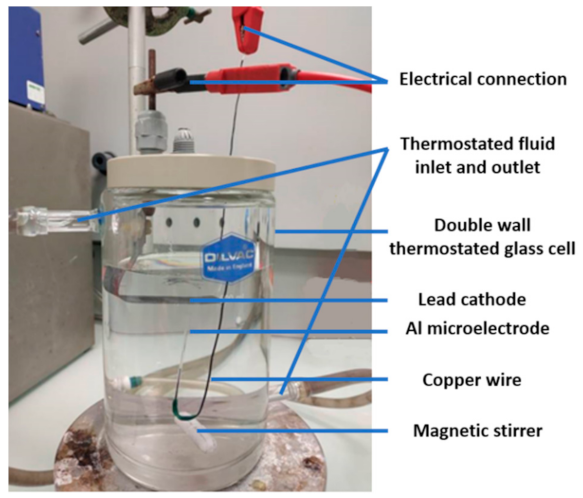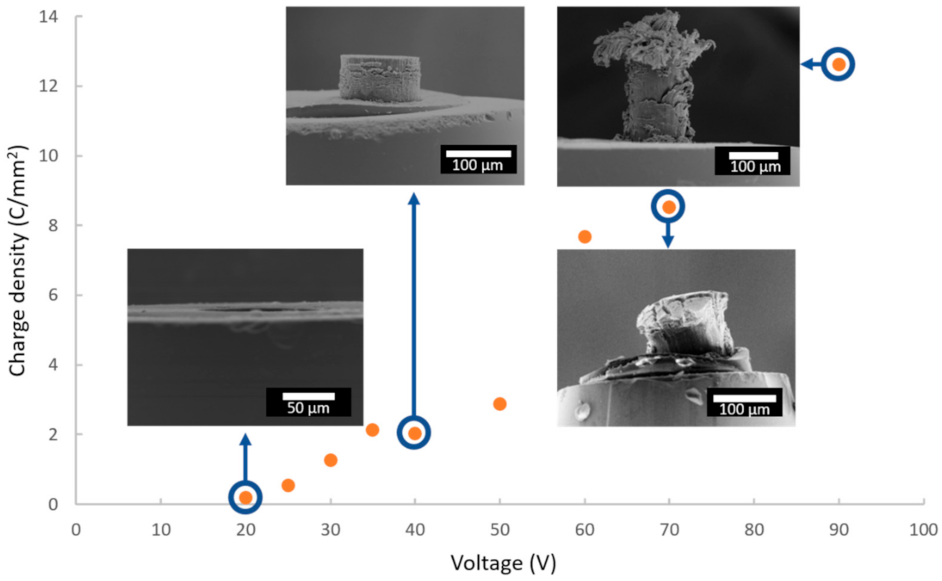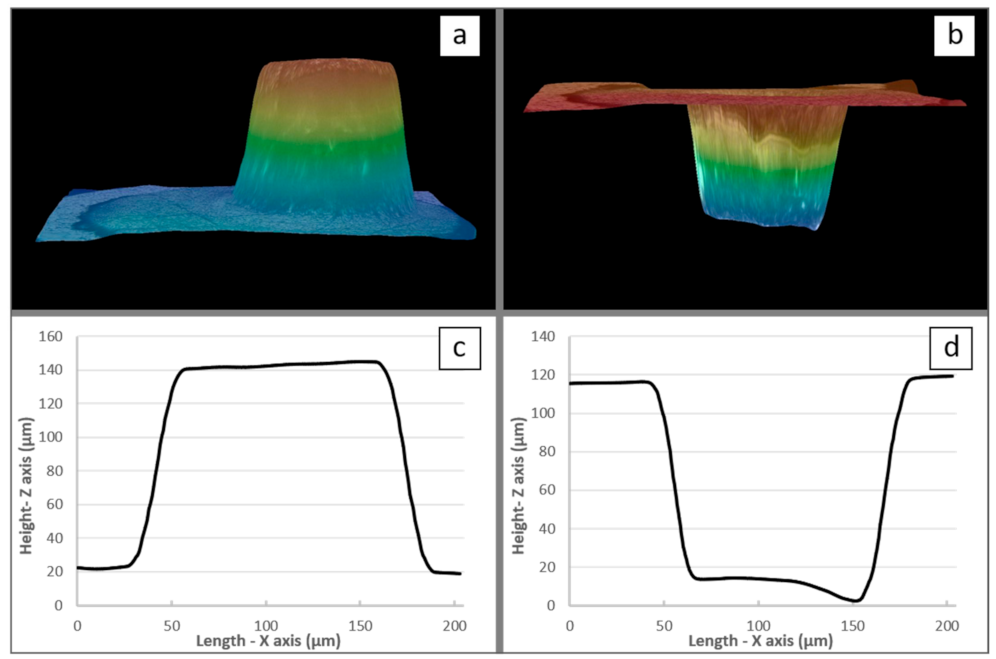Local Anodizing of a Newly Prepared Aluminum Micrometric Disk
Abstract
:1. Introduction
2. Materials and Methods
2.1. Innovating Fabrication of Disk-Shaped Aluminum Microelectrode
2.2. Local Anodizing and Subsequent Characterizations
3. Results
3.1. Influence of the Anodizing Voltage
3.2. Measurement of the Expansion Factor
4. Discussion
Author Contributions
Funding
Institutional Review Board Statement
Informed Consent Statement
Data Availability Statement
Acknowledgments
Conflicts of Interest
Appendix A
| Metal | Melting Point (°C) | Linear Thermal Expansion Coefficient (×107 K−1) |
|---|---|---|
| Platinum | 1768 | 90 |
| Gold | 1064 | 142 |
| Silver | 962 | 190 |
| Aluminum | 660 | 240 |
| Borosilicate | 821 (Tg) | 35 |
Appendix B
References
- Runge, J.M. The Metallurgy of Anodizing Aluminum, Chapter 2: A Brief History of Anodizing Aluminum; Springer International Publishing: Cham, Switzerland, 2018; pp. 65–148. ISBN 978-3-319-72177-4. [Google Scholar]
- Pribat, D.; Cojocaru, C.S.; Gowtham, M.; Marquardt, B.; Wade, T.; Wegrowe, J.E.; Kim, B.S. Organisation of carbon nanotubes and semiconductor nanowires using lateral alumina templates. Comptes Rendus Phys. 2009, 10, 320–329. [Google Scholar] [CrossRef] [Green Version]
- Sauer, I.; Doerr, C.; Schanze, T. Spike sorting: The overlapping spikes challenge. Curr. Dir. Biomedial Eng. 2015, 1, 42–45. [Google Scholar] [CrossRef]
- Ge, J.; Chow, D.N.; Fessler, J.L.; Weingeist, D.M.; Wood, D.K.; Engelward, B.P. Micropatterned comet assay enables high troughput and sensitive DNA damage quantification. Mutagenesis 2015, 30, 3011–3019. [Google Scholar] [CrossRef] [PubMed] [Green Version]
- Smith, L.W.; Pingel, V.J. A micro solution-potential measuring technique. J. Electrochem. Soc. 1951, 98, 48–50. [Google Scholar] [CrossRef]
- Asoh, H.; Uchibori, K.; Ono, S. Structural features of anodic oxide films formed on aluminum substrate coated with self-assembled microspheres. Corr. Sci. 2009, 51, 1496–1500. [Google Scholar] [CrossRef]
- Badets, V.; Loget, G.; Garrigue, P.; Sojic, N.; Zigah, D. Combined local anodization of titanium and scanning photoelectrochemical mapping of TiO2 spot arrays. Electrochem. Acta 2016, 222, 84–91. [Google Scholar] [CrossRef]
- Pilaski, M.; Lohrengel, M.M. Electrochemical microstructuring of ultra-thin passive films on aluminium. Electrochem. Acta 2003, 48, 1309–1313. [Google Scholar] [CrossRef]
- Siket, C.M.; Mardare, A.I.; Kaltenbrunner, M.; Bauer, S.; Hassel, A.W. Surface patterned dielectrics by direct writing of anodic oxides using scanning droplet cell microscopy. Electrochem. Acta 2013, 113, 755–761. [Google Scholar] [CrossRef]
- Arurault, L. Pilling-Bedworth ratio of thick anodic aluminium porous films prepared at high voltages in H2SO4 based electrolyte. Trans. Inst. Met. Finish. 2008, 86, 51–54. [Google Scholar] [CrossRef] [Green Version]
- Albu, S.P.; Schmuki, P. Influence of anodization parameters on the expansion factor of TiO2 nanotubes. Electrochim. Acta 2013, 91, 90–95. [Google Scholar] [CrossRef]
- Poznyak, A.; Pligovka, A.; Laryn, T.; Salerno, M. Porous alumina films fabricated by reduced temparatures sulfuric acid anodizing: Morphology, composition and volumetric growth. Materials 2021, 14, 767. [Google Scholar] [CrossRef] [PubMed]
- Zamora, G.; Arurault, L.; Winterton, P.; Bes, R. Impact of the type of anodic film formed and deposition time on the characteristics of porous anodic aluminium oxide films containing Ni metal. Chem. Pap. 2011, 65, 460–468. [Google Scholar] [CrossRef] [Green Version]
- Lee, W.; Ji, R.; Gösele, U.; Nielsch, K. Fast fabrication of long-range ordered porous alumina membranes by hard anodization. Nat. Mater. 2006, 5, 741–747. [Google Scholar] [CrossRef] [PubMed]
- Aerts, T.; Dimogerontakis, T.; De Greave, I.; Fransaer, J.; Terryn, H. Influence of the anodizing temperature on the porosity and the mechanical properties of the porous anodic oxide film. Surf. Coat. Technol. 2007, 201, 7310–7317. [Google Scholar] [CrossRef]
- Aerts, T.; De Greave, I.; Terryn, H. Control of the electrode temperature for electrochemical studies: A new approach illustrated on porous anodizing of aluminium. Electrochem. Commun. 2009, 11, 2292–2295. [Google Scholar] [CrossRef]
- Aerts, T.; Jorcin, J.-B.; De Greave, I.; Terryn, H. Comparison between the influence of applied electrode and electrolyte temperatures on porous anodizing of aluminum. Electrochim. Acta 2010, 55, 3957–3965. [Google Scholar] [CrossRef]
- Sulka, G.D.; Stepniowski, W.J. Structural features of self-organized nanopore arrays formed by anodization of aluminum in oxalic acid at relatively high temperatures. Electrochem. Acta 2009, 54, 3683–3691. [Google Scholar] [CrossRef]
- Thompson, G.E.; Wood, G.C. Chapter 5 Anodic films on aluminium, in Corrosion: Aqueous Processes and Passive Films. In Treatise on Materials Science and Technology; Scully, J.C., Ed.; Elsevier: Amsterdam, The Netherlands, 1983; Volume 23, pp. 205–329. ISBN 978-0-12-633670-2. [Google Scholar]
- Mezour, M.A.; Morin, M.; Mauzeroll, J. Fabrication and characterization of laser pulled platinum microelectrodes with controlled geometry. Anal. Chem. 2011, 83, 2378–2382. [Google Scholar] [CrossRef] [PubMed]
- Katemann, B.B.; Schuhmann, W. Fabrication and characterization of needle-type Pt-disk nanoelectrodes. Electroanalysis 2002, 14, 22–28. [Google Scholar] [CrossRef]







| Anodizing Voltage | Thickness (μm) | Expansion Factor (PBR) | Growth Rate (µm/h) |
|---|---|---|---|
| 20 | 3 | - | 9 |
| 35 | 109 | 1.96 | 327 |
| 40 | 115 | 1.80 | 345 |
| 50 | 218 | 2.10 | 654 |
Publisher’s Note: MDPI stays neutral with regard to jurisdictional claims in published maps and institutional affiliations. |
© 2022 by the authors. Licensee MDPI, Basel, Switzerland. This article is an open access article distributed under the terms and conditions of the Creative Commons Attribution (CC BY) license (https://creativecommons.org/licenses/by/4.0/).
Share and Cite
Cicutto, L.; Roche, J.; Arurault, L. Local Anodizing of a Newly Prepared Aluminum Micrometric Disk. Nanomaterials 2022, 12, 845. https://doi.org/10.3390/nano12050845
Cicutto L, Roche J, Arurault L. Local Anodizing of a Newly Prepared Aluminum Micrometric Disk. Nanomaterials. 2022; 12(5):845. https://doi.org/10.3390/nano12050845
Chicago/Turabian StyleCicutto, Ludovic, Jérome Roche, and Laurent Arurault. 2022. "Local Anodizing of a Newly Prepared Aluminum Micrometric Disk" Nanomaterials 12, no. 5: 845. https://doi.org/10.3390/nano12050845
APA StyleCicutto, L., Roche, J., & Arurault, L. (2022). Local Anodizing of a Newly Prepared Aluminum Micrometric Disk. Nanomaterials, 12(5), 845. https://doi.org/10.3390/nano12050845






